Season’s eatings: What to cook and eat in June
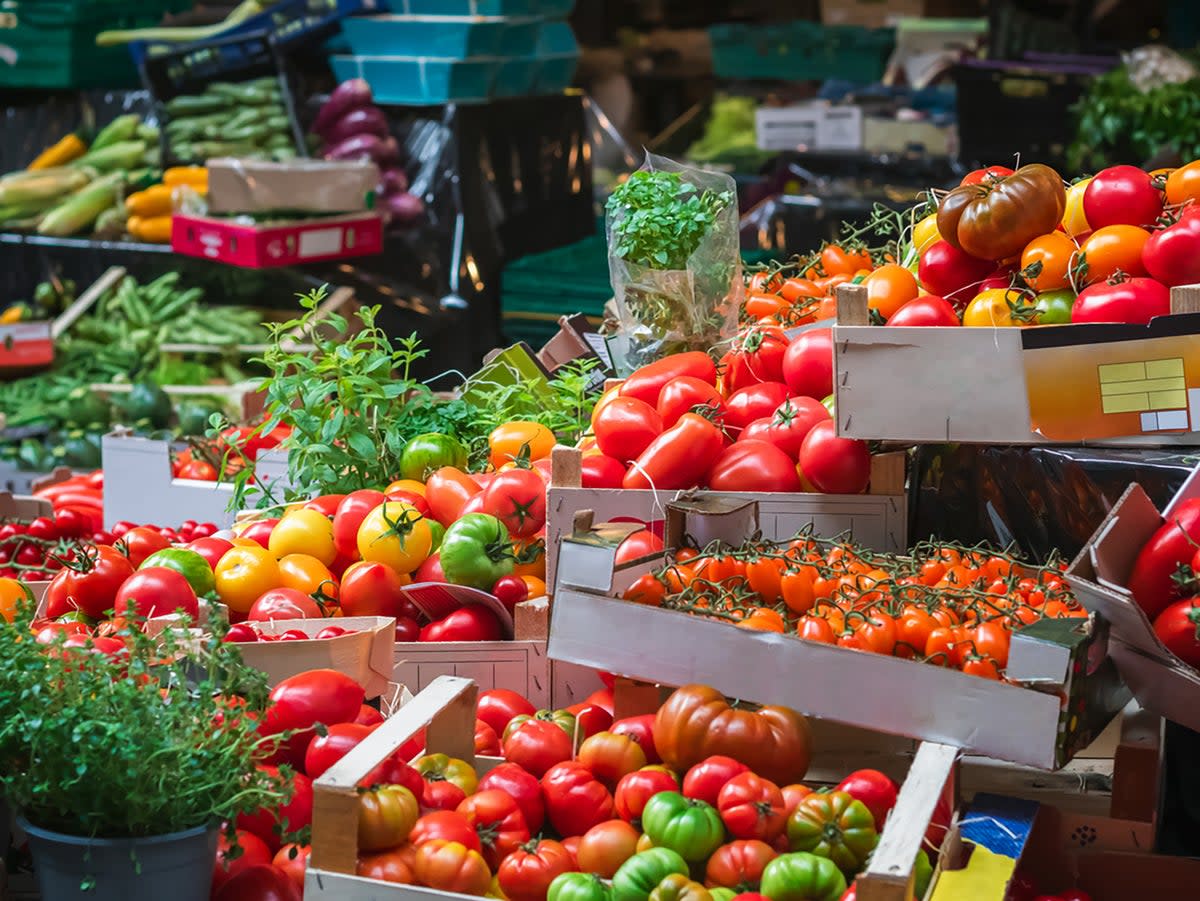
Despite the occasional shower or thunderstorm, summer is so close that we can almost taste it. This means delicious new ingredients are appearing in supermarkets, farmers’ markets and even our own gardens.
Eating locally and sustainably has never been more important, and with an abundance of fresh, in-season produce avilable in the UK in June, it’s the perfect time to enjoy nature’s bounty.
Focusing on seasonal fruits and vegetables not only supports local farmers but also reduces the environmental impact associated with long-distance food transportation.
We’ve selected our five favourite in-season items – tomatoes, globe artichokes, courgettes, fennel and strawberries
Tomatoes
Although botanically a fruit, tomatoes are commonly treated as a vegetable in culinary contexts due to their savoury flavour. Originating from western South America, they were brought to Europe by Spanish conquistadors in the 16th century, becoming a staple in northern Europe by the 19th century. Tomatoes are indispensable in Mediterranean cuisine, offering a sweet, tangy flavour and a wide range of culinary uses.
Tomatoes belong to the nightshade family, which includes aubergines, peppers and chillies. There are thousands of tomato varieties, ranging from large beefsteak tomatoes to tiny cherry tomatoes. The entire tomato, including the skin, flesh and seeds, is edible, though the green leaves are toxic.
To prepare tomatoes, wash them thoroughly and use as needed – whole, halved, quartered, sliced, chopped or diced. For sauces, removing the skin is recommended: blanch the tomatoes in boiling water, then peel. Besides fresh, tomatoes are available tinned, pulped, pureed and juiced.
Cooking methods for tomatoes are diverse. They can be roasted, grilled or fried and are essential in sauces, soups, stews and salads. Store tomatoes at room temperature to preserve their flavour; only refrigerate ripe tomatoes if necessary, bringing them back to room temperature before use.
When selecting tomatoes, choose firm ones with smooth skins and a noticeable aroma. Locally grown, vine-ripened tomatoes offer the best flavour. Different types of tomatoes serve various purposes: beefsteak for salads and grilling, salad tomatoes for versatility, cherry tomatoes for sweetness, plum tomatoes for sauces, and green and yellow varieties for unique culinary uses.
Roasted tomato, spinach and parmesan quiche

A buttery pastry filled with roasted cherry tomatoes, garlic and spinach, all bound together with a creamy egg and parmesan mixture – perfect for a picnic or a summery supper with a green salad.
Serves: 6
Time: 2 hours
Ingredients:
For the pastry:
250g plain flour, plus extra for dusting
125g chilled butter, diced
1 free-range egg yolk
For the filling:
200g cherry tomatoes, halved
1 head garlic, unpeeled cloves
2 tbsp olive oil
100g spinach
3 free-range eggs
250ml double cream
60g grated parmesan cheese
Salt and freshly ground black pepper
Method:
1. For the pastry, tip the flour in a bowl and add the pieces of butter. Rub in using your fingertips to a breadcrumb-like texture. Stir in the egg yolk – you may need a little more liquid to bring it together as a dough in which case you can add a splash of the separated egg white or just a little cold water. Using your hands, bring it together to make a dough, wrap in food-grade reusable beeswax wrap or cling film and set aside in the fridge for 20 minutes.
2. For the filling, preheat the oven to 180C/Gas 4 (fan). Put the cherry tomatoes, cut side-up on a lined baking tray. Scatter the unpeeled garlic cloves around and drizzle everything with half of the olive oil. Roast for 20 minutes, then remove from the oven and leave to cool, dabbing with a little kitchen paper to remove any excess moisture. Once cool enough to handle, unpeel the garlic and set aside.
3. Remove the pastry from the fridge and let it come to room temperature, then roll out the pastry on a lightly floured work surface and line a 23cm pastry case. Transfer the pastry-lined case to the fridge and leave for another 20 minutes or so.
4. To continue the filling, heat the remaining olive oil a frying pan. Add the spinach and cook for a minute or two, until wilted. Remove from the heat and leave to cool.
5. Cover the pastry base with parchment paper and fill the base with baking beans. Bake for 15 minutes at 180C/Gas 4 (fan) and then remove from the oven and carefully take the baking beans and paper out of the case. Return to the oven to bake for another 15 minutes.
6. To finish the filling, whisk the eggs in a bowl and add the double cream. Season with salt and freshly ground black pepper.
7. Remove the pastry case from the oven. Put nearly all the spinach in the base of the case and sprinkle over nearly all the cheese on top. Pour in two-thirds of the egg-cream mixture. Arrange the garlic cloves and cherry tomatoes on top. Dot in the remaining few leaves on spinach around the tomatoes and pour over the rest of the egg-cream mixture, followed by the remaining cheese.
8. Bake for 25-30 minutes, or until golden-brown and set. Leave to cool before slicing to serve.
Recipe from www.britishtomatoes.co.uk/british-tomato-fortnight
Globe artichoke
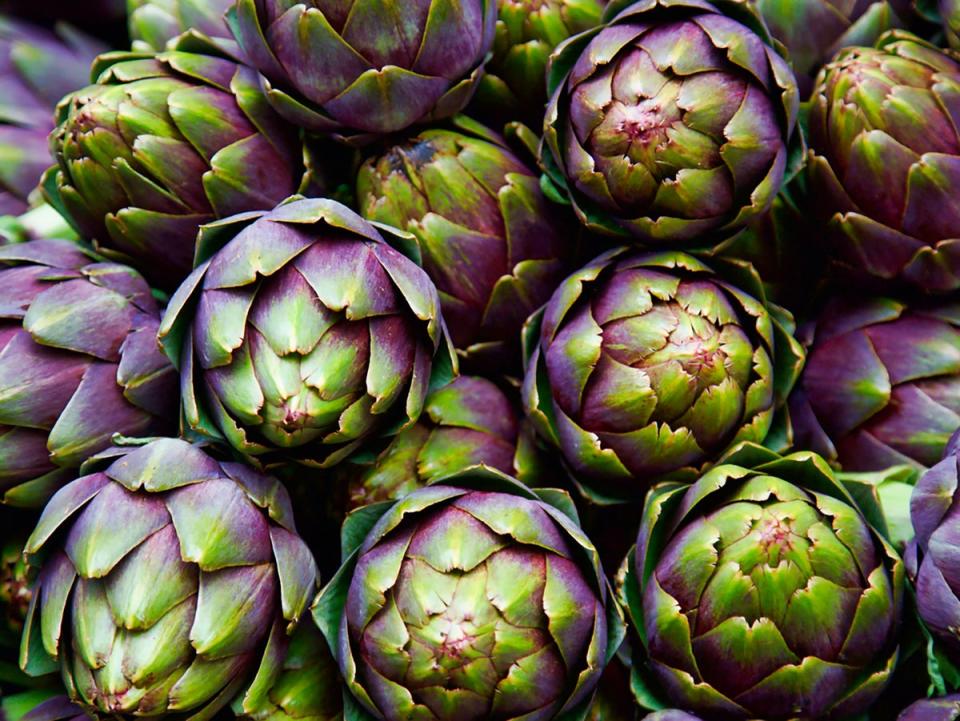
Globe artichokes, unrelated to the tuber-like Jerusalem artichoke, are the buds of a large thistle plant. They offer a distinctive culinary experience with their tender leaf ends and flavourful hearts, though their tough outer leaves and central choke are inedible.
Selecting the best globe artichokes involves choosing those with tightly packed, crisp green or purple leaves, which should feel heavy for their size. The leaves should produce a slight squeak when gently squeezed. Smaller artichokes tend to have more tender leaves, while larger ones boast bigger hearts, making them versatile for various dishes.
Preparing globe artichokes requires some attention to detail. First, trim the tough tips of the leaves and slice off the base to create a stable bottom. Remove the pointed top and pale centre leaves, then scoop out the furry choke with a spoon, taking care not to damage the underlying heart. To prevent browning, place the trimmed artichokes in water with a little lemon juice. Boil them in salted water for 35-45 minutes until the leaves can be easily pulled out, then drain them upside down.
Artichokes are best consumed on the day of purchase but can be stored in a perforated plastic bag in the fridge for a couple of days. Stainless steel, glass or enamel cookware is recommended to avoid discolouration during cooking.
Cooking globe artichokes offers several delightful options. Artichoke hearts are commonly found bottled in oil and can be used in Italian antipasti. Whole artichokes can be boiled or steamed, with the leaves dipped in hollandaise, melted butter or garlic butter. Alternatively, they can be stuffed with garlic, parsley, grated parmesan, and breadcrumbs, then baked. For a smoky flavour, artichokes can be barbecued or grilled: simply halve them, remove the choke, brush with olive oil and grill until tender.
Grilled artichokes with hollandaise

“Grilled artichokes with hollandaise are one of my all-time favourite summer foods. Grown up and sophisticated with an elegant hollandaise sauce, they are also romantic when shared and, for some reason, incredibly popular with small kids. You can make the hollandaise on the Egg, if you have one – if you don’t, Hayward recommends making ahead and storing in a flask.”
Serves: 4-8
Ingredients:
4 large globe artichokes
1 lemon, cut into 4 wedges
4 garlic cloves, left whole, but given a whack to slightly crush
1 large egg yolk
Juice of 1 lemon
200g/generous ¾ cup unsalted butter, melted
Olive oil, for brushing
Salt and freshly ground black pepper
Method:
1. Wrap the artichokes individually in a double layer of foil, each with two tablespoons of water, a lemon wedge, a garlic clove and a big pinch of salt. Using the indirect set-up, burp and open your preheated Egg, place the wrapped artichokes on the stainless steel grid and leave them to steam for about 45-60 minutes with the dome closed until tender.
2. Meanwhile, for the hollandaise, put the egg yolk and four teaspoons of lemon juice into a heatproof bowl with one teaspoon of water and whisk together for two to three minutes until thick. Very gradually, whisk in the melted butter (leaving the white milky solids behind) in a thin stream until thick and creamy. Season with salt, pepper and more lemon juice to taste. Keep the hollandaise sauce warm over a pan of boiling water off the heat, stirring occasionally.
3. Burp the Egg and remove the convEggtor. Unwrap and halve the artichokes, top to bottom/vertically, then paint the cut side with olive oil. Using the direct set-up, grid cut-side down on the bars in the Egg until golden brown. Sprinkle with salt to taste just before serving.
Recipe from ‘Big Green Egg Feasts: Innovative Recipes To Cook For Friends And Family’ by Tim Hayward (Quadrille, £30).
Courgettes
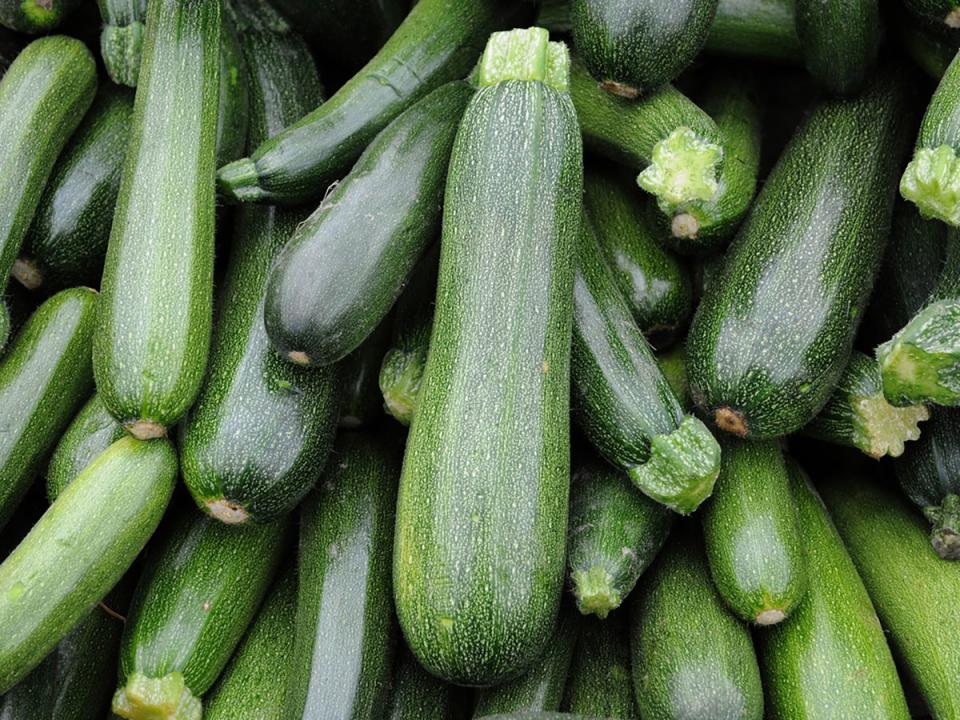
As courgettes come into season from June to September in the UK, it’s the perfect time to enjoy this versatile and tender vegetable. Courgettes are a member of the cucurbit family, which includes cucumbers, squashes and melons. Their deep green skin and fire pale flesh make them a popular choice in a variety of dishes.
When preparing courgettes, there’s no need to peel them. Simply slice off each end and follow the recipe’s instructions. They can be thinly sliced and enjoyed raw, adding a fresh crunch to salads.
For cooking courgettes, avoid boiling as it makes them mushy and diminishes their flavour. Instead try lightly frying them in butter or oil with a splash of water. Roasting courgettes until tender and golden enhances their natural flavour, while marinating and grilling them creates a delightful charred and soft texture. Courgettes are also excellent in stir-fries, curries or fried in a light batter.
There are many delicious recipes to explore with courgettes. For a savoury treat, stuff them with a mixture of rice, herbs and cheese, or use them in a light and refreshing courgette ribbon salad. For a hearty family meal, bake a courgette and tomato gratin, layering thin slices with tomatoes and cheese for a comforting dish. Courgettes can even be used in sweet dishes like courgette muffins.
When selecting courgettes, choose small ones that are firm with glossy, unblemished skin. Avoid any that are soft or squishy. If courgettes aren’t available consider using squash or marrow as alternatives.
Courgette fritto
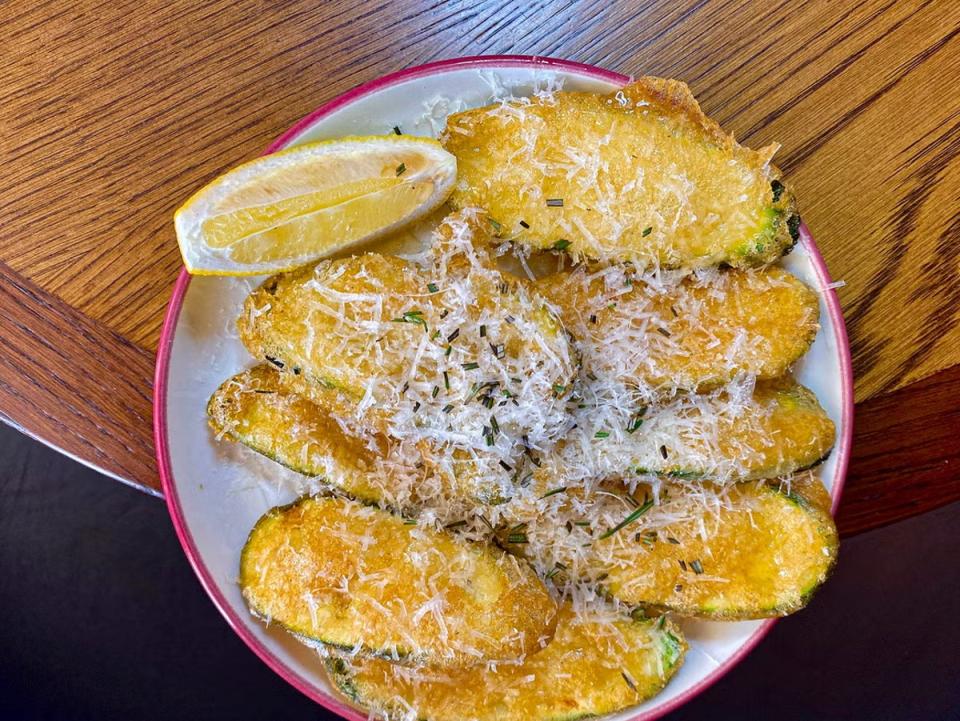
Ingredients:
6 large green courgettes
Squeezy honey
Grated pecorino
Fresh rosemary
Lemon wedges
Salt and pepper
Extra flour for dusting
For the batter:
200g gluten-free self-raising flour
320g water
2g ground cumin
2g onion powder
2g salt
Equipment:
Deep fryer (or deep frying pan and a thermometer)
Method:
1. Using a bowl and whisk, mix all the dry ingredients for the batter.
2. To prevent lumps, add half the water to create a smooth slurry, then add the rest and whisk to an even consistency.
3. Slice the courgettes at an angle into long discs approximately 3-5mm thick.
4. Set the deep fryer to 180C.
5. Dust the courgettes lightly with some extra gluten-free flour and shake off the excess.
6. Submerge in the batter, drip off the excess, and gently fry for 45 seconds on each side. Once golden brown, drain onto paper towel.
7. To finish, arrange onto a plate, drizzle with honey and season with salt and pepper, sprinkle with grated pecorino and chopped fresh rosemary.
8. Serve with a lemon wedge.
Recipe from Tutto, Brighton
Fennel

Known for its strong aniseed flavour, fennel is something you either love or hate. Also called Florence fennel, finocchio or sweet fennel, it is popular in Italian cuisine and resembles a heavy-bottomed celery with its bulb-like shape.
When raw, fennel is crisp with a pronounced flavour, but cooking makes it softer and more mellow. To prepare fennel, wash it thoroughly and trim off the green tops, which can be used as a garnish. Remove the shoots and root, and peel off the tougher outer layer until the bulb is young and tender. For whole cooking, cut out the central core, leaving a cone-shaped cavity, or slice it if preferred. Alternatively, chop into quarters and remove the core from each piece, taking care not to remove too much to keep the quarters intact.
Fennel can be enjoyed in various ways. Slice it very thinly for salads using a mandolin for best results. Boil or steam fennel for up to 20 minutes if whole, or up to 12 minutes for wedges. Roasting fennel enhances its flavour, taking 40-50 minutes to become tender and caramelised.
To store fennel, wrap freshly cut pieces in damp kitchen paper and place them in the fridge, where they will last up to three days. Fennel tends to discolour quickly after being cut, so dress raw fennel for salads immediately or toss it in a little lemon juice to prevent browning.
When selecting fennel, choose smaller, young bulbs for their tenderness. The bulbs should be white and free of blemishes, and the feathery green tops should appear fresh and bright without yellowing. For those who might not enjoy fennel’s strong flavour, alternatives like dill or fennel herb can provide a similar but milder taste.
Whole roast salmon with fennel, baby tomatoes and garlic-herb pangrattato
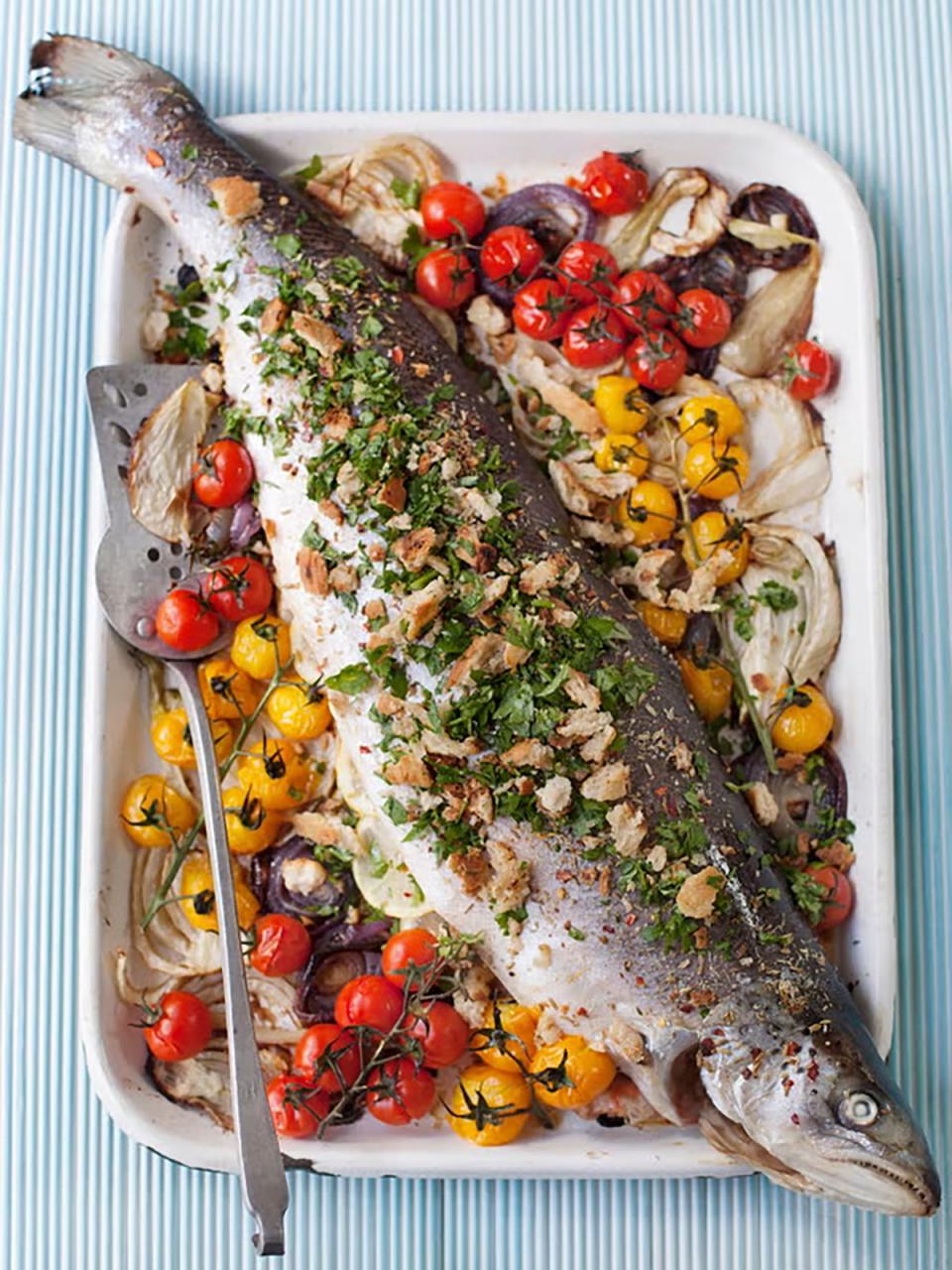
“I usually pair the Mediterranean flavours of tomatoes and fennel with white fish, but after trying this combination the other day, I’m hooked – the salmon makes for a richer result, which suits the change in temperature perfectly.”
Ingredients:
1 tbsp fennel seeds
2 tsp dried chilli flakes
2 lemons, zested and sliced
1 tbsp sea salt
2kg salmon, gutted and cleaned
½ bunch parsley, chopped, stalks reserved
1 bulb fennel, sliced lengthways
2 red onions, sliced into rings
2 tbsp olive oil, plus extra to drizzle
200g cherry tomatoes on the vine
200g cherry yellow tomatoes on the vine
3 thick slices sourdough, torn into small pieces
2 cloves garlic, crushed
Method:
1. Preheat the oven to 200C/400F/Gas6. Grind the fennel seeds, chilli, zest and salt with a mortar and pestle then sprinkle the mix inside and over the salmon and place most of the lemon slices and the parsley stalks into the cavity. Lay the rest of the lemon slices on the base of a large baking tray, then put the salmon on top.
2. Arrange the fennel and onion in the tray then drizzle with 1 tbsp of oil and cook for 20 minutes. Remove from the oven and add the tomatoes and an extra drizzle of oil, and cook for 15 minutes or until the fish is cooked through.
3. Heat 1 tbsp of oil in a large pan, add the bread pieces and garlic and cook over a medium heat for 8 to 10 minutes or until golden. Remove and allow to cool before stirring through the parsley.
4. Serve the fish with the veggies, extra pan juices and crunchy crumbs scattered over the top.
Recipe from Bill Granger
Strawberries
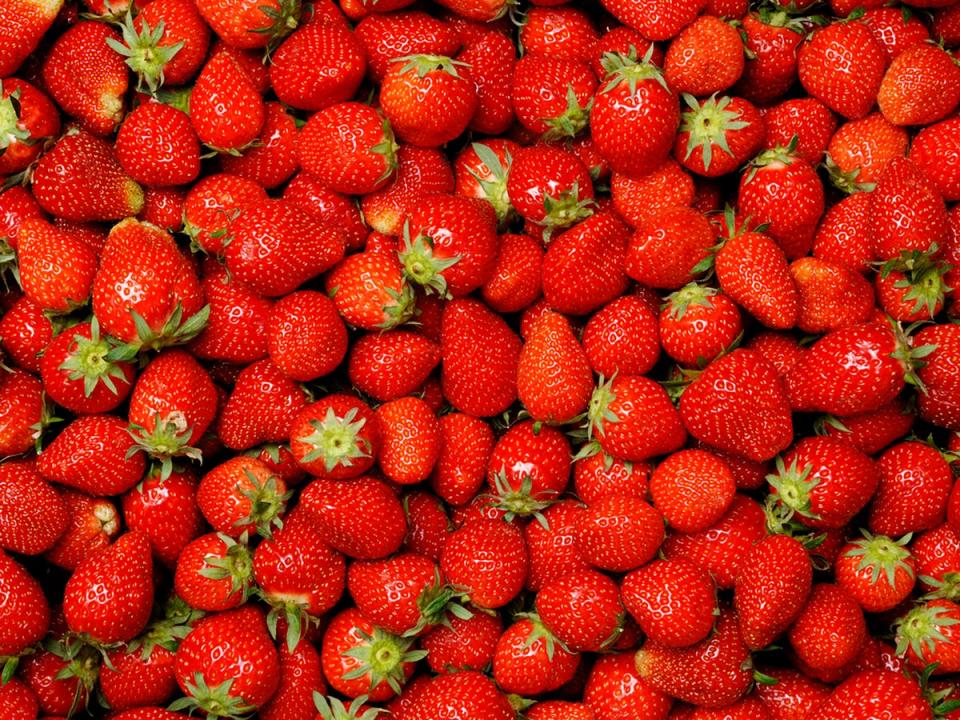
Strawberries, once a seasonal delight in Britain, are now available year-round due to imports from warmer climates. However, imported varieties are often chosen for their durability in transport rather than their taste, leading to less flavourful berries. These strawberries are picked before ripening, which further diminishes their taste since they don’t ripen after being picked.
For the best experience, it’s worth waiting for the British strawberry season, which runs from late May to early September. Super-ripe strawberries can be enjoyed through pick-your-own farms, ensuring the freshest and most flavourful berries.
Strawberries are easy to grow at home, whether in a garden or a pot on a sunny windowsill. Protecting them from birds when the fruits appear is essential for a successful harvest.
When selecting strawberries, look for plump, shiny berries with a bright colour and sweet aroma, keeping their leafy green calyx and stalk attached. Avoid any mushy or mouldy ones. If buying a punnet, ensure the underside isn’t stained, indicating crushed berries. Smaller to medium-sized strawberries often have a better flavour than larger ones, which can be watery.
Common varieties like Elsanta are sweet but have a high water content, giving them a crisp texture. For more flavourful and tender strawberries, look for British varieties such as Ava, Florence, Alice and Rhapsody. Wild fraises des bois from France are also a treat with their intense aroma and flavour.
To prepare strawberries, wash them briefly to avoid mushiness, hull them and keep them whole, halved or quartered as needed. Store strawberries in the fridge on a layer of kitchen paper to prevent crushing, and bring them to room temperature before eating. Never wash them before refrigerating, as this makes them soggy. Consume within a couple of days of purchase or picking.
Enjoy strawberries raw with cream or ice cream, or sprinkled with a little balsamic vinegar. They are also great in fruit salads, jams, tarts, or as a topping for desserts. If strawberries are unavailable, raspberries make a good alternative.
The easiest strawberry vanilla mousse (vegan)

Makes: 4-6 servings
Ingredients:
600g seasonal sweet strawberries
125ml melted coconut oil
1 vanilla pod (bean), scraped
To serve:
Fresh strawberries or raspberries
Mint leaves or edible flowers
Method:
1. Add all the mousse ingredients to a high-speed blender and blitz until well incorporated. The mixture needs to emulsify properly.
2. The oil needs to completely emulsified with the strawberry, so make sure there are no white dots in the mix and it’s just a beautiful pink colour throughout.
3. Pour into individual glasses and let the mousse set in the fridge for 3 hours. Once set, top with fresh strawberry slices or other berries.
Recipe from Bettina Campolucci Bordi


